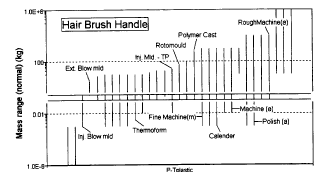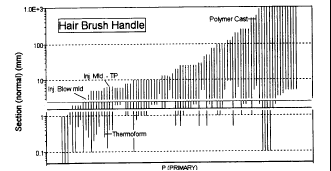| Determine performance indices for materials selection without shape | |
| Use the CMS software to screen materials for selection of materials without shape | |
| Use the tables in the text to develop performance indices | |
| Use the CMS software to screen or select between processing options |
A Look Ahead:
This case is taken from the notes that
accompanied the Cambridge Materials selector and discusses selection of
process. We will discussing process selection briefly this week.
However, we will be mainly discussing materials selection without
shape this week. The purpose of the example is to get everyone started
on how to use the CMS software for materials selection and
process selection. It is included as a look ahead for those students including
process selection in their case study as well as a benefit to all by providing
a first look at the other application of CMS. We will be discussing process
selection in two weeks. Also, we will be delaying the study of the Aerospace
Corporation case study until we get far enough into CMS, namely about two-to-three
weeks from now. Based on the experience of earlier courses,
it seems better to push a little harder earlier on rather
than have an end term crunch.
 |
Figure 8.1 A Hair Brush Handle |
Table 8.1 Hair Brush Handle: design requirements
| Material Class: | nylon (thermoplastic polymer) |
| Process Class: | primary, discrete |
| Shape Class: | 3D-solid |
| Mass: | 0.1-0.2 kg |
| Minimum Section: | 2 mm |
| Surface Finish: | 0.5 pm |
| Batch Size: | 100,000 |
The Selection
The selection has three stages. Figure 8.2 shows the first: a chart
of mass range against material class. A selection box for the brush handle
is shown on it. It identifies the processes which satisfy the first set
of design requirements. Only processes which can shape thermoplastic polymers
are plotted. Almost all of them are capable of the desired mass range.
 |
Figure 8.2 A chart of mass range against material class.
Processes capable of forming thermoplastic polymers
are plotted. The box specifies the ones which can handle a mass range of 0.1 -0.2 kg. |
Figure 8.3 shows the second selection stage: a bar-chart of section
thickness against process class, selecting "primary" from the process class
menu. The selection box spans the thickness range 1.5 -
2.5
mm. Again, many processes pass.
 |
Figure 8.3 A chart of section thickness range against process class. The box isolates processes which can produce section thicknesses in the range 1.5 2.5 mm. |
A third stage is required as shown in Figure 8.4: a chart of surface
roughness against shape class. Only processes which can handle "3D-solid"
shapes (selected on the x-axis) are plotted. The selection box specifies
processes which can produce a surface finishof 0.5 mm
or better. Such a demanding requirement causes many processes to fail thisstage.
Some polymer processes pass -
however, except
for injection molding of thermoplastics, the others are for thermosets
and therefore have previously failed the material stage.
 |
Figure 8.4 A chars of surface roughness against shape class. The box isolates processes which can shape 3D-solid shapes and produce surfaces of high smoothness. |
Consideration of the three selection stages reveals that only one process - injection molding- has passed them all, as indicated in Table 8.2.
Table 8.2: Processes for the brush handle
| Injection Molding - thermoplastics |
Injection molding emerges as the only process which satisfies all the design requirements. Because of the high tooling cost associated with injection molding, the process is only economical for large batch sizes (Figure 8.5). The large number of handles required means that the cost will be amortized over a large number of components and, therefore, the cost of one handle can be kept low. In practice, brush handles are made commercially using injection molding.
 |
Figure 8.5 Economic batch size against process class. The selection box specifies the desired batch size of 100,000. |
| ASM pages 281 - 295 | |
| Ashby pages 56 - 69 |
| How can you determine performance indices for different problems where shape isn't an issue? | |
| How does process considerations enter into the selection process? | |
| How can sequential selection criteria be adjusted to provide more or fewer materials |
Ashby problems B 3.1, B 3.3, B 3.6, and B 3.9
(Due 10/7/98)
Subject: Week
5 - Ashby B 3.1, 3.3, 3.6 & 3.9
Outline Case Study Functional Requirements and
Indices (Due 10/16/98)
Subject: Week
5 - Case Study Functional Requirements and Indices
The Functional Requirements and Indices section of the report is the
third element in the case study. As discussed in class, the elements of
the case study , as you will assemble them over the course of the quarter
are:
Presentation of Case Study Detailed
Background (Class period 10/2/98)
This page gives background and an introduction to process selection
software, the other part of the materials selection process. You would
be well advised to bookmark this page for use when we get to the processing
part of the course.
http://www-materials.eng.cam.ac.uk/research/process_selection/
| Online Course Support |